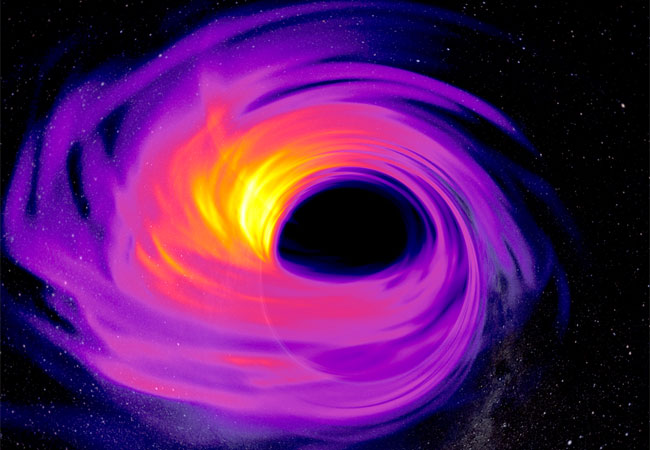Event Horizon Telescope is measuring the shadow of the black hole at the center of the Galaxy

Quelle: Uni Frankfurt
Due to the strong pull of gravity, not even light can escape from black holes, whose surface, i.e., the event horizon, cannot be observed directly. However, the boundary which separates photons that are trapped from those that can escape from the incredible gravitational pull is called the black-hole “shadow”, because it would appear as a shadow against a bright lit background.
It is such a shadow that is the target of series of observations presently ongoing of Sgr A*, the name of the black-hole candidate in our Milky Way. During the observations, the researchers will analyze the radio emission emitted by Sgr A*, whose mass is 4.5 million times that of our Sun and whose shadow is about half of the size of the distance between the Sun and the Earth.
Despite being so massive, Sgr A* is also very far from us, at a 26,000 light years, making the angular size of the shadow extremely small. Measuring the emission from this surface is therefore equivalent to imaging an apple on the surface of the Moon. To accomplish this ambitious project several radio telescopes across the globe are connected and thus form a virtual telescope with a diameter comparable to the Earth. This technique is called Long Baseline Interferometry (VLBI).
The work of BlackHoleCam is lead by Prof. Luciano Rezzolla (ITP, Frankfurt), Prof. Michael Kramer (Max Planck Institute for Radio Astronomy, Bonn), and by Prof. Heino Falcke (Radboud-University Nijmegen, Netherlands); all of them are important contributors of the EHT collaboration.
In the current observations of Sgr A*, network of radiotelescopes from Europe, the United States of America, Middle- and South America, and the South Pole telescope are participating at the same time. During the observations, each telescope records the data on hard disks which are shipped after the end of the campaign to one of the high-performance computer centers in the US or to Bonn. In these centers the individual data of the telescopes are combined by supercomputers and an image can be reconstructed.
This shadow image can be regarded as the starting point for the theoretical research of Prof. Rezzolla's group. Besides predicting theoretically what type of image scientists is expected to observe, the group in Frankfurt is also working on determining whether it will be possible to establish if Einstein’s theory of general relativity is the correct theory of gravity.
There are several other theories of gravity besides the well-known one by Einstein and the observations of the black-hole shadow may help to identify the true one. Because of this, scientists in Frankfurt analyze the size and the geometry of the shadow and compare them to synthetic images generated on supercomputers which model accretion flows onto black holes..
These images are computed by solving the equations of relativistic magneto-hydrodynamics and tracing the orbit of photons around black holes in different theories of gravity using state-of-the art numerical tools developed in the group of Prof. Rezzolla. Comparing the synthetic shadow to the observed one may shed light on the existence of one of the most extreme predictions of Einstein’s theory of gravity: the existence of black holes.
However, as Prof. Rezzolla remarks, “These observations represent a major step forward in the international attempt of understanding the nature of the dark and compact object at the centre of our Galaxy. However, they are just the first step and it is likely that many more observations of increasing precision will be necessary for finally settling this fundamental issue.”
Further Information: Prof. Luciano Rezzolla, Institut für Theoretische Physik, Fachbereich 13, Campus Riedberg, (069)-798-47871; rezzolla@th.physik.uni-frankfurt.de
Media Contact
All latest news from the category: Physics and Astronomy
This area deals with the fundamental laws and building blocks of nature and how they interact, the properties and the behavior of matter, and research into space and time and their structures.
innovations-report provides in-depth reports and articles on subjects such as astrophysics, laser technologies, nuclear, quantum, particle and solid-state physics, nanotechnologies, planetary research and findings (Mars, Venus) and developments related to the Hubble Telescope.
Newest articles

Trotting robots reveal emergence of animal gait transitions
A four-legged robot trained with machine learning by EPFL researchers has learned to avoid falls by spontaneously switching between walking, trotting, and pronking – a milestone for roboticists as well…

Innovation promises to prevent power pole-top fires
Engineers in Australia have found a new way to make power-pole insulators resistant to fire and electrical sparking, promising to prevent dangerous pole-top fires and reduce blackouts. Pole-top fires pose…

Possible alternative to antibiotics produced by bacteria
Antibacterial substance from staphylococci discovered with new mechanism of action against natural competitors. Many bacteria produce substances to gain an advantage over competitors in their highly competitive natural environment. Researchers…





















